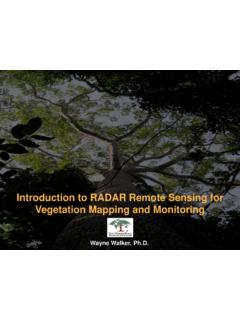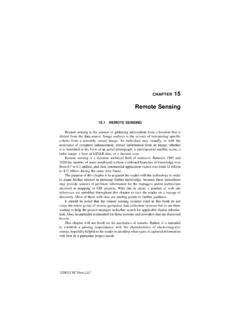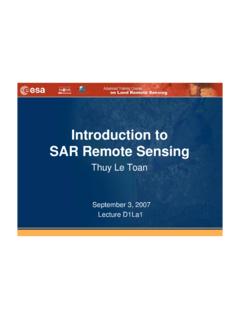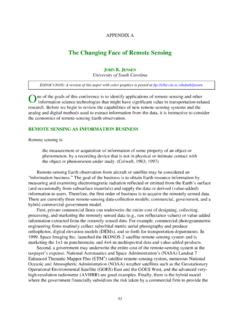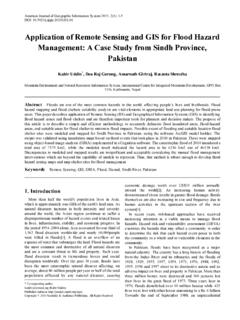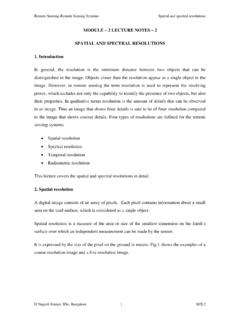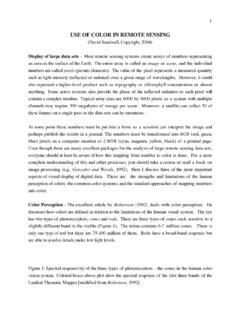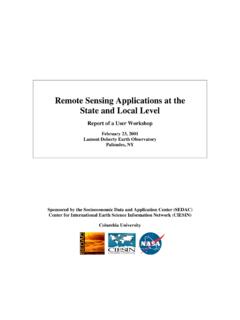Transcription of application of remote sensing and gis - Prof. S. …
1 application of remote sensing and GIS Prof. S. Ramachandran Vice Chancellor Madras University oastal areas, the place where the waters of the seas meet the land are indeed unique places in our global geography. They are endowed with a very wide range of coastal ecosystems like mangroves, coral reefs, lagoons, sea grass, salt marsh, estuary etc. They are unique in a very real economic sense as sites for port and harbour facilities that capture the large monetary benefits associated with waterborne commerce and are highly valued and greatly attractive as sites for resorts and as vacation destinations. The combination of freshwater and salt water in coastal estuaries creates some of the most productive and richest habitats on earth; the resulting bounty in fishes and other marine life can be of great value to coastal nations.
2 In many locations, the coastal topography formed over the millennia provides significant protection from hurricanes, typhoons, and other ocean related disturbances. But these values could diminish or even be lost, if they are not managed. Pollution of coastal waters can greatly reduce the production of fish, as can degradation of coastal nursery grounds and other valuable wetland habitats. The storm protection afforded by fringing reefs and mangrove forests can be lost if the corals die or the mangroves removed. Inappropriate development and accompanying despoilment can reduce the attractiveness of the coastal environment, greatly affecting tourism potential. Even ports and harbours require active management if they are to remain productive and successful over the long term. Coastal ecosystem management is thus immensely important for the sustainable use, development and protection of the coastal and marine areas and resources.
3 To achieve this, an understanding of the coastal processes that influence the coastal environments and the ways in which they interact is necessary. It is advantageous to adopt a holistic or systematic approach for solving the coastal problems, since understanding the processes and products of interaction in coastal environments is very complicated. A careful assessment of changes that occur in the coastal C 541 application of remote sensing and GIS environments and in coastal ecosystems forms a major milestone for effective coastal ecosystem management and leads to sustainable utilization of coastal resources. All these can be achieved only through the collection of accurate, reliable and comprehensive set of scientific data. remote sensing technology in recent years has proved to be of great importance in acquiring data for effective resources management and hence could also be applied to coastal environment monitoring and management (Ramachandran, 1993, Ramachandran , 1997, 1998).
4 Further, the application of GIS (Geographical Information System) in analyzing the trends and estimating the changes that have occurred in different themes helps in management decision making process. remote sensing Technology remote sensing is the technique of deriving information about objects on the surface of the earth without physically coming into contact with them. This process involves making observations using sensors (cameras, scanners, radiometer, radar etc.) mounted on platforms (aircraft and satellites), which are at a considerable height from the earth surface and recording the observations on a suitable medium (images on photographic films and videotapes or digital data on magnetic tapes). When electromagnetic radiation falls upon a surface, some of its energy is absorbed, some is transmitted through the surface, and the rest is reflected.
5 Surfaces also naturally emit radiation, mostly in the form of heat. It is that reflected and emitted radiation which is recorded either on the photographic film or digital sensor. Since the intensity and wavelengths of this radiation are a function of the surface in question, each surface is described as processing a characteristic Spectral Signature . If an instrument can identify and distinguish between different spectral signatures, then it will be possible to map the extent of surfaces using remote sensing . Satellite remote sensing is widely used as a tool in many parts of the world for the management of the resources and activities within the continental shelf containing reefs, islands, mangroves, shoals and nutrient rich waters associated with major estuaries. Satellites & Sensors The mode can be geostationary, permitting continuous sensing of a portion of the earth or sun synchronous with polar orbit covering the entire earth at the same equator crossing time.
6 The Landsat series of satellites have a repeat period ranging from 16 18 days, whereas in the case of IRS, it is 22 days. Satellites cover the same area and provide S. Ramachandran 542 continuous coverage of a fixed area. The sun synchronous satellites have a synoptic coverage. The ground area covered by the satellite s passes can be obtained by referring to its path and row. Sensors are devices used for making observations. They consist of mechanisms usually sophisticated lenses with filter coatings to focus the area observed onto a plane in which detectors are placed. These detectors are sensitive to a particular region in which the sensor is designed to operate and produce outputs, which are either representative of the observed area as in the case of the camera or produce electrical signals proportionate to radiation intensity.
7 Spatial resolution: It is a measure of the smallest angular or linear separation between two objects that can be resolved by the sensor. The greater the sensor s resolution, the greater the data volume and smaller the area covered. In fact, the area coverage and resolution are inter dependant and these factors determine the scale of the imagery. Spectral resolution: It refers to the dimension and number of specific wavelength intervals in the electromagnetic spectrum to which a sensor is sensitive. Narrow bandwidths in certain regions of the electromagnetic spectrum allow the discrimination of various features more easily. Temporal resolution: It refers to how often a given sensor obtains imagery of a particular area. Ideally, the sensor obtains data repetitively to capture unique discriminating characteristics of the phenomena of interest.
8 Radiometric sensitivity: It is the capability to differentiate the spectral reflectance/ emittance from various targets. This depends on the number of quantisation levels within the spectral band. In other words, the number of bits of digital data in the spectral band will decide the sensitivity of the sensor. Geographical Information Systems A Geographical Information System (GIS) is a system of hardware, software and procedures to facilitate the management, manipulation, analysis, modeling, representation and display of geo referenced data to solve complex problems regarding planning and management of resources. Functions of GIS include data entry, data display, data management, information retrieval and analysis. The applications of GIS include mapping locations, quantities and densities, finding distances and mapping and monitoring change.
9 543 application of remote sensing and GIS Function of an Information system is to improve one s ability to make decisions. An Information system is a chain of operations starting from planning the observation and collection of data, to store and analysis of the data, to the use of the derived information in some decision making process. A GIS is an information system that is designed to work with data referenced to spatial or geographic coordinates. GIS is both a database system with specific capabilities for spatially referenced data, as well as a set of operation for working with data. There are three basic types of GIS applications which might also represent stages of development of a single GIS application Inventory application Many times the first step in developing a GIS application is making an inventory of the features for a given geographic area.
10 These features are represented in GIS as layers or themes of data. The emphasis at this stage of application development consists of updating and simple data retrieval. Analysis application Upon completion of the inventory stage, complex queries on multiple layers can be performed using spatial and aspatial analysis techniques. Management application More advanced spatial and modelling techniques are required to support the decisions of managers and policy makers. This involves shifting of emphasis from basic geographic data handling to manipulation, analysis and modelling in order to solve real world problems. Uses Of Coastal GIS Packages of information of any specific site. 2. Provision of summary data for planning purpose. 3. Graphical display for educational and public relation exercise.


